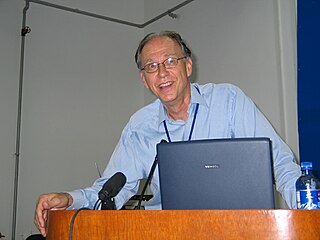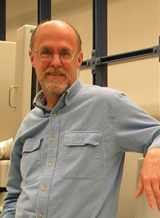Related Research Articles

John Frederick William Birney is joint director of EMBL's European Bioinformatics Institute (EMBL-EBI), in Hinxton, Cambridgeshire and deputy director general of the European Molecular Biology Laboratory (EMBL). He also serves as non-executive director of Genomics England, chair of the Global Alliance for Genomics and Health (GA4GH) and honorary professor of bioinformatics at the University of Cambridge. Birney has made significant contributions to genomics, through his development of innovative bioinformatics and computational biology tools. He previously served as an associate faculty member at the Wellcome Trust Sanger Institute.

Boreoeutheria is a magnorder of placental mammals that groups together superorders Euarchontoglires and Laurasiatheria. The clade includes species as diverse as giraffes, pigs, zebras, rhinos, dogs, cats, rabbits, mice, squirrels, bats, whales, dolphins, lemurs, monkeys, and humans.

Michael Spencer Waterman is a Professor of Biology, Mathematics and Computer Science at the University of Southern California (USC), where he holds an Endowed Associates Chair in Biological Sciences, Mathematics and Computer Science. He previously held positions at Los Alamos National Laboratory and Idaho State University.

David Haussler is an American bioinformatician known for his work leading the team that assembled the first human genome sequence in the race to complete the Human Genome Project and subsequently for comparative genome analysis that deepens understanding the molecular function and evolution of the genome.

Webb Colby Miller is an American bioinformatician who is professor in the Department of Biology and the Department of Computer Science and Engineering at The Pennsylvania State University.

Eugene Wimberly "Gene" Myers, Jr. is an American computer scientist and bioinformatician, who is best known for contributing to the early development of the NCBI's BLAST tool for sequence analysis.
Anders Krogh is a bioinformatician at the University of Copenhagen, where he leads the university's bioinformatics center. He is known for his pioneering work on the use of hidden Markov models in bioinformatics, and is co-author of a widely used textbook in bioinformatics. In addition, he also co-authored one of the early textbooks on neural networks. His current research interests include promoter analysis, non-coding RNA, gene prediction and protein structure prediction.

Phylo is an experimental video game about multiple sequence alignment optimisation. Developed by the McGill Centre for Bioinformatics, it was originally released as a free Flash game in November 2010. Designed as a game with a purpose, players solve pattern-matching puzzles that represent nucleotide sequences of different phylogenetic taxa to optimize alignments over a computer algorithm. By aligning together each nucleotide sequence, represented as differently coloured blocks, players attempt to create the highest point value score for each set of sequences by matching as many colours as possible and minimizing gaps.

Lincoln David Stein is a scientist and Professor in bioinformatics and computational biology at the Ontario Institute for Cancer Research.
The ISCB Overton Prize is a computational biology prize awarded annually for outstanding accomplishment by a scientist in the early to mid stage of his or her career. Laureates have made significant contribution to the field of computational biology either through research, education, service, or a combination of the three.
The ISCB Accomplishment by a Senior Scientist Award is an annual prize awarded by the International Society for Computational Biology for contributions to the field of computational biology.

Adam C. Siepel is an American computational biologist known for his research in comparative genomics and population genetics, particularly the development of statistical methods and software tools for identifying evolutionarily conserved sequences. Siepel is currently Chair of the Simons Center for Quantitative Biology and Professor in the Watson School for Biological Sciences at Cold Spring Harbor Laboratory.

David Sankoff is a Canadian mathematician, bioinformatician, computer scientist and linguist. He holds the Canada Research Chair in Mathematical Genomics in the Mathematics and Statistics Department at the University of Ottawa, and is cross-appointed to the Biology Department and the School of Information Technology and Engineering. He was founding editor of the scientific journal Language Variation and Change (Cambridge) and serves on the editorial boards of a number of bioinformatics, computational biology and linguistics journals. Sankoff is best known for his pioneering contributions in computational linguistics and computational genomics. He is considered to be one of the founders of bioinformatics. In particular, he had a key role in introducing dynamic programming for sequence alignment and other problems in computational biology. In Pavel Pevzner's words, "Michael Waterman and David Sankoff are responsible for transforming bioinformatics from a ‘stamp collection' of ill-defined problems into a rigorous discipline with important biological applications."

Ron Shamir is an Israeli professor of computer science known for his work in graph theory and in computational biology. He holds the Raymond and Beverly Sackler Chair in Bioinformatics, and is the founder and former head of the Edmond J. Safra Center for Bioinformatics at Tel Aviv University.

Alfonso Valencia is a Spanish biologist, ICREA Professor, current director of the Life Sciences department at Barcelona Supercomputing Center, of Spanish National Bioinformatics Institute (INB-ISCIII), and coordinator of the data pillar of the Spanish Personalised Medicine initiative, IMPaCT. From 2015 to 2018, he was President of the International Society for Computational Biology.

Gary Stormo is an American geneticist and currently Joseph Erlanger Professor in the Department of Genetics and the Center for Genome Sciences and Systems Biology at Washington University School of Medicine in St Louis. He is considered one of the pioneers of bioinformatics and genomics. His research combines experimental and computational approaches in order to identify and predict regulatory sequences in DNA and RNA, and their contributions to the regulatory networks that control gene expression.
ISCB Fellowship is an award granted to scientists that the International Society for Computational Biology (ISCB) judges to have made “outstanding contributions to the fields of computational biology and bioinformatics”. As of 2019, there are 76 Fellows of the ISCB including Michael Ashburner, Alex Bateman, Bonnie Berger, Steven E. Brenner, Janet Kelso, Daphne Koller, Michael Levitt, Sarah Teichmann and Shoshana Wodak. See List of Fellows of the International Society for Computational Biology for a comprehensive listing.
Katherine Snowden Pollard is the Director of the Gladstone Institute of Data Science and Biotechnology and a professor at the University of California, San Francisco (UCSF). She is a Chan Zuckerberg Biohub Investigator. She was awarded Fellowship of the International Society for Computational Biology in 2020 and the American Institute for Medical and Biological Engineering in 2021 for outstanding contributions to computational biology and bioinformatics.
References
- 1 2 3 Mathieu Blanchette publications indexed by Google Scholar
- 1 2 3 Blanchette, Mathieu Daniel (2002). Algorithms for Phylogenetic Footprinting (PhD thesis). University of Washington. ProQuest 305515226.
- 1 2 "Mathieu Blanchette - Assistant Professor, School of Computer Science, McGill University" . Retrieved 2 March 2014.
- 1 2 Mathieu Blanchette at DBLP Bibliography Server
- 1 2 Blanchette, Mathieu's publications indexed by the Scopus bibliographic database. (subscription required)
- ↑ Blanchette, M.; Kent, W. J.; Riemer, C.; Elnitski, L.; Smit, A. F.; Roskin, K. M.; Baertsch, R.; Rosenbloom, K.; Clawson, H.; Green, E. D.; Haussler, D.; Miller, W. (2004). "Aligning Multiple Genomic Sequences with the Threaded Blockset Aligner". Genome Research. 14 (4): 708–715. doi:10.1101/gr.1933104. PMC 383317 . PMID 15060014.
- ↑ Thomas, J. W.; Touchman, J. W.; Blakesley, R. W.; Bouffard, G. G.; Beckstrom-Sternberg, S. M.; Margulies, E. H.; Blanchette, M; Siepel, A. C.; Thomas, P. J.; McDowell, J. C.; Maskeri, B; Hansen, N. F.; Schwartz, M. S.; Weber, R. J.; Kent, W. J.; Karolchik, D; Bruen, T. C.; Bevan, R; Cutler, D. J.; Schwartz, S; Elnitski, L; Idol, J. R.; Prasad, A. B.; Lee-Lin, S. Q.; Maduro, V. V.; Summers, T. J.; Portnoy, M. E.; Dietrich, N. L.; Akhter, N; et al. (2003). "Comparative analyses of multi-species sequences from targeted genomic regions". Nature. 424 (6950): 788–93. Bibcode:2003Natur.424..788T. doi:10.1038/nature01858. PMID 12917688. S2CID 2419233.
- ↑ Blanchette, M; Tompa, M (2002). "Discovery of regulatory elements by a computational method for phylogenetic footprinting". Genome Research. 12 (5): 739–48. doi:10.1101/gr.6902. PMC 186562 . PMID 11997340.
- ↑ Guillemette, B; Bataille, A. R.; Gévry, N; Adam, M; Blanchette, M; Robert, F; Gaudreau, L (2005). "Variant histone H2A.Z is globally localized to the promoters of inactive yeast genes and regulates nucleosome positioning". PLOS Biology. 3 (12): e384. doi: 10.1371/journal.pbio.0030384 . PMC 1275524 . PMID 16248679.

- ↑ Margulies, E. H.; Blanchette, M; NISC Comparative Sequencing Program; Haussler, D; Green, E. D. (2003). "Identification and characterization of multi-species conserved sequences". Genome Research. 13 (12): 2507–18. doi:10.1101/gr.1602203. PMC 403793 . PMID 14656959.
- 1 2 3 "CompleteCV-2015" (PDF). Retrieved 26 April 2021.
- 1 2 3 4 Maisel, M. (2006). "ISCB Honors Michael S. Waterman and Mathieu Blanchette". PLOS Computational Biology. 2 (8): e105. Bibcode:2006PLSCB...2..105M. doi: 10.1371/journal.pcbi.0020105 . PMC 1526462 .

- ↑ Blanchette, M; Green, E. D.; Miller, W; Haussler, D (2004). "Reconstructing large regions of an ancestral mammalian genome in silico". Genome Research. 14 (12): 2412–23. doi:10.1101/gr.2800104. PMC 534665 . PMID 15574820.
- ↑ Blanchette, M (2012). "Exploiting ancestral mammalian genomes for the prediction of human transcription factor binding sites". BMC Bioinformatics. 13 (Suppl 19): S2. doi: 10.1186/1471-2105-13-S19-S2 . PMC 3526440 . PMID 23281809.

- ↑ Chen, X; Blanchette, M (2007). "Prediction of tissue-specific cis-regulatory modules using Bayesian networks and regression trees". BMC Bioinformatics. 8 (Suppl 10): S2. doi: 10.1186/1471-2105-8-S10-S2 . PMC 2230503 . PMID 18269696.

- ↑ "McGill gets four Sloans". www.mcgill.ca. Retrieved 2 March 2014.
- ↑ "Algorithms for Molecular Biology - Editorial Board". www.almob.org. Retrieved 2 March 2014.